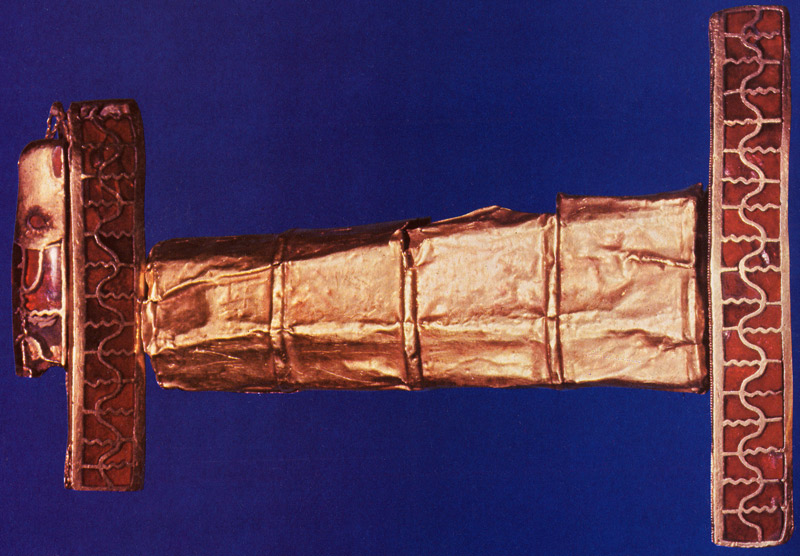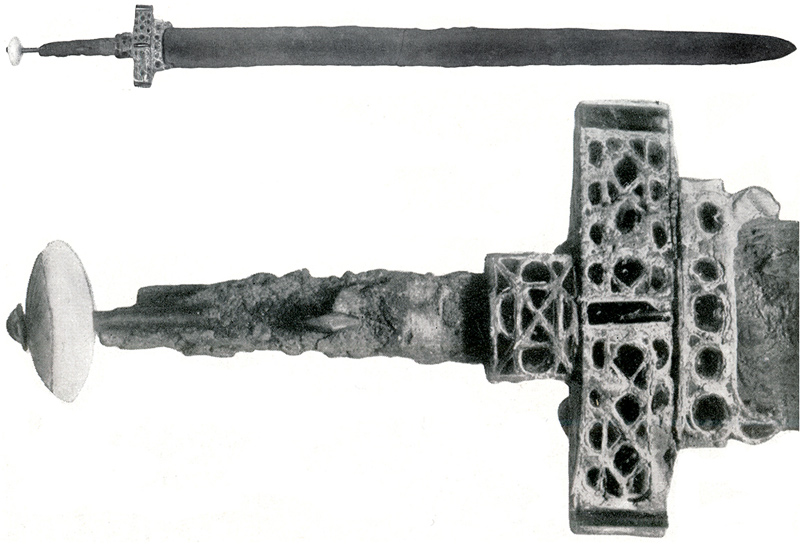
| myArmoury.com is now completely member-supported. Please contribute to our efforts with a donation. Your donations will go towards updating our site, modernizing it, and keeping it viable long-term.
Last 10 Donors: Anonymous, Daniel Sullivan, Chad Arnow, Jonathan Dean, M. Oroszlany, Sam Arwas, Barry C. Hutchins, Dan Kary, Oskar Gessler, Dave Tonge (View All Donors) |
| Author |
Message |
|
Peter Lyon
Industry Professional
|
 Posted: Wed 11 Feb, 2009 11:02 pm Post subject: 5th-6th century sword questions Posted: Wed 11 Feb, 2009 11:02 pm Post subject: 5th-6th century sword questions |
 |
|
I have a couple of questions about 5th-6th century European/British swords - not my main area of knowledge, so hopefully someone might be able to answer these.
The composite handguard and pommels I have seen all seem to use either wood, horn or bone for the middle piece, with metal plates each side. What other materials were used? In particular I am interested to know if rock crystal or other transparent/translucent materials were ever used.
The rings on hilts, especially pommels. When did they appear and disappear? And what is the current thinking on their function?
Still hammering away
|
|
  |
 |
|
Jeroen Zuiderwijk
Industry Professional
|
 Posted: Thu 12 Feb, 2009 1:35 am Post subject: Re: 5th-6th century sword questions Posted: Thu 12 Feb, 2009 1:35 am Post subject: Re: 5th-6th century sword questions |
 |
|
| Peter Lyon wrote: | I have a couple of questions about 5th-6th century European/British swords - not my main area of knowledge, so hopefully someone might be able to answer these.
The composite handguard and pommels I have seen all seem to use either wood, horn or bone for the middle piece, with metal plates each side. What other materials were used? In particular I am interested to know if rock crystal or other transparent/translucent materials were ever used. |
AFAIK only organic materials or metal (f.e. iron with niello and silver inlay).
| Quote: | | The rings on hilts, especially pommels. When did they appear and disappear? And what is the current thinking on their function? |
They occured during the Vendel period, around 6th-8th century. The latest theory AFAIK is that they're tied in to the custom of ring giving, where the ring bearer makes a commitment (which probably is where exchanging rings in marriage also comes from) and the ring represents loyalty to the giver.
Jeroen Zuiderwijk
- Bronze age living history in the Netherlands
- Barbarian metalworking
- Museum photos
- Zip-file with information about saxes
|
|
   |
 |
|
Peter Johnsson
Industry Professional
|
 Posted: Thu 12 Feb, 2009 1:46 am Post subject: Posted: Thu 12 Feb, 2009 1:46 am Post subject: |
 |
|
Hi Peter!
The rings on hilts appear sometimes late 6th C and go out of fashion during the late 7th C. I´ve never tried to nail down an exact dating or period for this feature, so this is more a general guide, than an exact timing.
In the very early stages the ring was an actual ring and a separate piece held with a U-shaped device. Rather early on it became a feature, rather than a proper ring: a very fat doughnut shape that was made in one piece with the U-shaped securing device.
It is speculated if the ring is a mark of rank and that it may have been used in the swearing of oaths (warrior kissing the ring on the hilt of his lord´s sword).
The hilts with a true articulated ring have these upper hilts that are less wide and with "stubbier" proportions: a bit like the pommel of the Sutton Hoo sword.
When the ring becomes a more pronounced feature, it turns into a gesture, not being a true ring any more. These can be very "fat" but are made hollow. The upper hilts they sit on are generally wider and of a proportionately thinner cross section than the earlier type.
In the later examples the decoration becomes more elaborate and almost baroque, with an abundance of niello, silver and garnets in some examples.
Earlier hilts can be more severe and restrained, with zoomorphic motifs on the small pommel mostly and restrained deocrative lines on other parts of the hilt.
On hilt materials, I have heard of wood, horn and bone being used as the "spacer". I have seen swords with bronze or iron (sometimes with silvering/gilding) as the "spacer" and then it is common to see niello and/or garnet inlays as well.
Never seen or heard about rock crystal or amber or any such used for the hilts. Could look very nice on a version of the Excalibur however  
EDIT:
Hey Jeroen!
Simultaneous posting!
It makes sense what you say it is the receiver who gets the ring sword and not like I had heard it is the sword of the lord that has the ring in the hilt to swear on. The kings in the sagas are called Ring Givers, after all!
There are also quite a few of these ring swords. If they were exclusively for the lord to have, there would have been vary many lords around....
|
|
   |
 |
|
Jeroen Zuiderwijk
Industry Professional
|
 Posted: Thu 12 Feb, 2009 2:56 am Post subject: Posted: Thu 12 Feb, 2009 2:56 am Post subject: |
 |
|
| Peter Johnsson wrote: |
EDIT:
Hey Jeroen! |
Hi Peter!
| Quote: | | Simultaneous posting! |
Yep, happens occasionally it seems 
| Quote: | It makes sense what you say it is the receiver who gets the ring sword and not like I had heard it is the sword of the lord that has the ring in the hilt to swear on. The kings in the sagas are called Ring Givers, after all!
There are also quite a few of these ring swords. If they were exclusively for the lord to have, there would have been vary many lords around.... |
Yeah, and that's also probably why the Sutton Hoo sword doesn't have a ring, as the owner was a king!
Jeroen Zuiderwijk
- Bronze age living history in the Netherlands
- Barbarian metalworking
- Museum photos
- Zip-file with information about saxes
|
|
   |
 |
|
Jean-Carle Hudon
|
 Posted: Thu 12 Feb, 2009 6:18 am Post subject: unarticulated rings Posted: Thu 12 Feb, 2009 6:18 am Post subject: unarticulated rings |
 |
|
Peter,
thank you for that explanation. I have the del tin lombard model, ordered because I liked the look of it and the period, but I was disappointed that the ring was fixed in the hilt , which I only realized when I received it.
I wrote Del Tin about that, and he assured me that he copied a true weapon, which left me perplexed. I did not doubt his word for a moment, but couldn't figure out why one would bother to have a ring if the darn thing isn't really a ring, but the evocation of a ring. This intrigued me as I knew that ''true'' ring hilts did exist, ie with a ring that could still move.
So thank you for that, now I have an answer to give visitors who see the model on my wall and ask why....JCH
Bon coeur et bon bras
|
|
  |
 |
M. Eversberg II

|
 Posted: Thu 12 Feb, 2009 10:53 am Post subject: Posted: Thu 12 Feb, 2009 10:53 am Post subject: |
 |
|
Where can I drum up some extant examples of these ring swords? Sounds like a fascinating tradition. This early portion of the middle ages is almost totally mystery to me.
M.
This space for rent or lease.
|
|
      |
 |
G Ezell
Industry Professional

Location: North Alabama Joined: 22 Dec 2003
Posts: 235
|
|
   |
 |
|
Antonio Lamadrid
|
|
  |
 |
Kirk Lee Spencer

|
 Posted: Thu 12 Feb, 2009 6:13 pm Post subject: Re: 5th-6th century sword questions Posted: Thu 12 Feb, 2009 6:13 pm Post subject: Re: 5th-6th century sword questions |
 |
|
| Peter Lyon wrote: | .... In particular I am interested to know if rock crystal or other transparent/translucent materials were ever used.
The rings on hilts, especially pommels. When did they appear and disappear? And what is the current thinking on their function? |
Some horn is translucent, especially the lighter caramel colored horn. I believe it would be very fine looking in the upper and lower guard of the more slim forms..
Transparent/Translucent garnet and enamel has been used in the guard of Behmer type 3 swords.
Also Type 4 swords, from further east, have what looks like small pommels made of stone. If so, I don't see why they could not use rock crystal.
There were also stones attached to the scabbards.
If I remember correctly their is another conjecture related to the loose ring type ringhilts in which the ring was used to secure what were called "peace bands"... some kind of band that secured the sword into the scabbard to demonstrate willingness to parley without violence (sort of like having your swords "safety" witched on.)
ks
 Attachment: 149.46 KB Attachment: 149.46 KB

Behmer Type 3. Childeric Garnet Hilt. Frankish. Image from "Barbarian Kings" by Lionel Casson
 Attachment: 139.24 KB Attachment: 139.24 KB

Behmer Type 4 from Taman Russia Preserved in the State Museum Berlin
Two swords
Lit in Eden’s flame
One of iron and one of ink
To place within a bloody hand
One of God or one of man
Our souls to one of
Two eternities
|
|
  |
 |
David Huggins

|
 Posted: Fri 13 Feb, 2009 2:45 am Post subject: Ring Posted: Fri 13 Feb, 2009 2:45 am Post subject: Ring |
 |
|
The ring also appears on other objects, a shield boss, drinking horn, lower part of a crossguard so I think the theory concerning the 'peace band' has to be looked at again. Fellow forumite has some intersting things to say about the 'ring' in his fourthcoming book and I wouldn't like to be a spoiler by revealing to much at the moment!
Apart from garnet inlay i can't think of any mineral use in hilt garniture.
best
Dave
( nice image being provided o this thread  ) )
and he who stands and sheds blood with us, shall be as a brother.
|
|
   |
 |
M. Eversberg II

|
 Posted: Fri 13 Feb, 2009 6:13 am Post subject: Posted: Fri 13 Feb, 2009 6:13 am Post subject: |
 |
|
The "evolution" drawing and the PDF present it very well. The later form of the ring hilt, though, why does it look more like a blob hilt? It's almost as if someone took a stone, wrapped it in a bit of foil, and stapled it to my sword.
M.
This space for rent or lease.
|
|
      |
 |
|
|
You cannot post new topics in this forum
You cannot reply to topics in this forum
You cannot edit your posts in this forum
You cannot delete your posts in this forum
You cannot vote in polls in this forum
You cannot attach files in this forum
You can download files in this forum
|
All contents © Copyright 2003-2024 myArmoury.com — All rights reserved
Discussion forums powered by phpBB © The phpBB Group
Switch to the Basic Low-bandwidth Version of the forum
|

